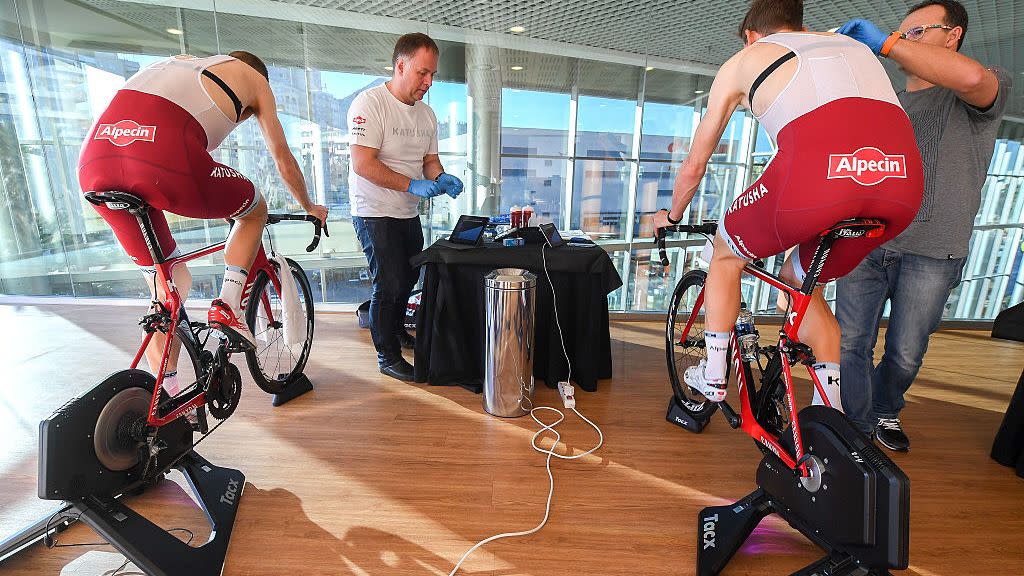Is Lactate Testing the Next Big Thing in Biosensors for Cyclists?

Lactate testing has long been reserved for pro riders or amateurs with big budgets who are happy to spend time riding the trainer in a lab as they get poked and prodded with needles. But now, it may be the next big thing in biosensors that are more readily available and can be used in real world conditions rather than a lab.
Will they be more helpful than a heart rate monitor, power meter, or continuous glucose monitor? Some experts say yes. Does that mean the UCI will race to ban them? Already done.
Essentially, being able to monitor blood lactate continuously will allow riders to know just how hard they’re pushing, and allow them to really dial in staying at endurance pace, also known as Zone 2. Because of this, it’s no surprise that researcher and cycling physiology expert Iñigo San Millán recently told Velo that biosensors like this would revolutionize the way racers approach training and racing.
San Millán is best known for his work around Zone 2 training, as well as his in-depth work with the UAE Team Emirates riders, Tadej Pogačar in particular.
Researchers in 2022 noted that “the continuous availability of data on lactate levels during exercise could help to adjust the training intensity and improve the performance of athletes... Lactate sensing is an important measurement in the scientific training of athletes to improve their performance.”
Lactate testing uses blood lactate to find the point where your body starts to produce more and more lactate, creating threshold zones based on these findings. These measurements are similar to heart rate or power zones but arguably more accurate, since they’re based on entirely internal biological values.
This allows riders to get a lot more specific with their training, and know exactly when they’re leaving that endurance zone and are going to be burning more matches, even if they don’t necessarily feel it.
This is akin to the benefits of a continuous glucose monitor (CGM), which in theory can help a rider avoid a bonk by alerting the rider to falling blood glucose levels. With a continuous lactate monitor, a rider would be alerted that he’s about to leave Zone 2, and can meter his pace to stay within the zone.
As for what these innovations will look like in the pro peloton, we know that right now, like CGMs, continuous lactate monitors are banned in-race by the UCI. According to rule 1.3.006bis, “Devices which capture other physiological data, including any metabolic values such as but not limited to glucose or lactate are not authorised in competition.”
So you won’t be seeing data transmitted or collected during any race—however, like a CGM, the lactate monitors may provide useful data during training that can translate to race day. And a CLM may be more aligned with smart training versus racing anyway: if the break is going or the peloton is surging, a rider isn’t going to be helped by the fact that their lactate levels are rapidly increasing. Go time is go time. A CGM, on the other hand, can still be helpful during a breakaway, alerting a rider that despite the hard effort they’re doing, it’s still time for a gel.
Non-invasive or less-invasive continuous lactate monitors have been in development for years now, but according to Velo, many pro cyclists are opting for blood lactate testing the old-fashioned way, with a pinprick (similar to how you would test blood glucose without a CGM).
Testing in 2022 for a bloodless sensor found that the data was useful, but the product’s efficacy trailed off after several weeks of use and that it wasn’t yet commercially viable. Also in 2022, researchers in San Diego began showing their sensor that monitors lactate, glucose and alcohol simultaneously (and looks like a standard CGM).
“This is like a complete lab on the skin,” said center director Joseph Wang, a professor of nanoengineering at UC San Diego. “It is capable of continuously measuring multiple biomarkers at the same time, allowing users to monitor their health and wellness as they perform their daily activities.”
No device like this is currently available on the market, but based on the development and explosion of popularity for CGM devices, it’s a safe bet that a CLM available to the public isn’t too far off. Several companies already exist marketing them, though none are publicly available yet.
You Might Also Like

